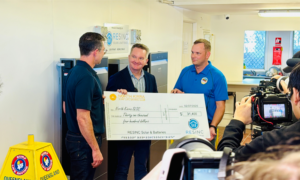A short time ago, the Australian Government released a much awaited white paper with details of its carbon reduction targets, energy efficiency and renewable energy initiatives and emissions trading scheme; due to commence on July 1, 2010.
The release of the white paper followed yesterday’s announcement by Prime Minister Kevin Rudd of the fast tracking of funding for solar power projects, with an apparent focus on solar farms. Earlier today, Climate Change Minister Penny Wong also announced funding of $1.4 billion over five years to help the small business and community sector adjust to the introduction of an emissions trading scheme.
Carbon Pollution Reduction Scheme highlights
Key points from the white paper include:
* The Scheme will put a price on carbon in a systematic way throughout the economy. It employs a ‘cap and trade’ system whereby emitters of greenhouse gases need to acquire a permit for every tonne of greenhouse gas that they emit. Certain categories of firms will receive an administrative (free) allocation of permits, as a transitional measure. Permits will be tradable and will be able to be banked indefinitely.
* The Government has stayed committed to meeting a long-term target of a 60 per cent reduction in greenhouse gas emissions from 2000 levels by 2050 and has committed to reduce Australia’s greenhouse gas emissions by between 5 per cent and 15 per cent below 2000 levels by the end of 2020.
However, only the 5 per cent level represents an unconditional commitment to reduce emissions by that amount by 2020. The 15 per cent level represents a commitment to reduce emissions if a global agreement where all major economies commit to substantially restrain emissions and all developed countries take on comparable reductions to that of Australia.
* An increase in household electricity bills of around $4 per week is expected if the carbon price is set at $25 when the scheme is introduced.
* All low–income households will receive additional support to fully meet the expected overall increase in the cost of living flowing from the scheme and around 97 per cent of middle-income households will receive some direct cash assistance.
* Motorists will be protected from higher fuel costs from the scheme by ‘cent for cent’ reductions in fuel tax for the first three years.
* The Government will establish a $2.15 billion Climate Change Action Fund over five years to ease the transition for businesses and community sector organisations to a carbon-costed environment. The funding will assist investment in energy efficiency enhancing equipment (e.g. solar hot water, insulation and lighting) that meets established energy saving criteria.
* The Renewable Energy Target requires 20 per cent of Australia’s electricity to be sourced from renewable generators by 2020. The white paper acknowledges the need for rapid, large scale deployment of renewable technology. Design of the expanded national Renewable Energy Target is well under way, and draft legislation is planned to be released for public comment later in December 2008. Legislative and regulatory amendments to implement the design of the Renewable Energy Target are expected to be in place by mid-2009, with revised targets commencing from 2010.
* Renewable energy is being further supported though the $500 million Renewable Energy Fund, with funding fast tracked to be distributed over 18 months rather than 6 years. Further details of how the funding will be allocated are unclear, however the focus still appears to be on projects that take technology from the laboratory and into the field.
* Renewable energy targets under the scheme will increase substantially in the period to 2020 – from 9 500 MWh to 45 000 MWh.
The white paper is bound to have mixed reactions, particularly given the lack of further detail on renewable energy incentives and the “solar revolution” Kevin Rudd alluded to yesterday; the future home solar power rebates and feed in tariffs; and what appears to be a great deal of support for “clean coal”; aka new generation coal or low-emissions coal sector as an ongoing and viable industry in the long term.
Some major environmental groups and scientists are also likely to be bitterly disappointed after having urged a 40 per cent carbon reduction goal by 2020, or at the very least a commitment to reduction of 25 per cent – a minimum level they say would need to occur to avoid dangerous climate change.
Al Gore, former US vice president, Nobel Prize laureate and the creator of the iconic documentary “An Inconvenient Truth”, recently stated at UN climate talks in Poznan, Poland that it was critical to limit carbon dioxide levels in the atmosphere to 350 parts per million (ppm). Current atmospheric levels already exceed 380ppm, hence the need for reduction targets to be upped dramatically.
Various emissions- heavy local industries will likely be pleased with many aspects of the scheme, after lobbying intensively for far less than a 25% reduction target, claiming increased costs through an emissions trading scheme based on that figure would threaten investment and employment.
However, many commentators have pointed out a major and rapid shift to renewable energy would in fact create many thousands of new, well paying jobs and see billions of dollars of new investment in Australia’s clean tech sector. The white paper reinforces this view, stating Australia’s transition to a low pollution economy is expected to see the renewable energy industry grow to around 30 times its current size by 2050.












































